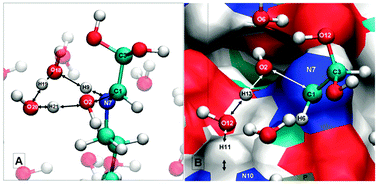A DFT study of the carboxymethyl-phosphatidylethanolamine formation from glyoxal and phosphatidylethanolamine surface. Comparison with the formation of N(ε)-(carboxymethyl)lysine from glyoxal and l-lysine
Abstract
Mechanisms of the generation of carboxymethyl compounds Nε-(carboxymethyl)lysine (CML) and carboxymethyl-phosphatidylethanolamine (CM-PE) from the reactions between glyoxal and L-lysine, and glyoxal and phosphatidylethanolamine (PE) were studied using the DFT method at the PBE/DNP level of theory. In order to study the reaction with PE, a periodic model of the PE surface was built. The starting surface model includes two molecules of PE, a molecule of monohydrated form of glyoxal, and five water molecules as explicit solvent that form a hydrogen bond network, which are involved in the reactions by stabilizing reaction intermediates and transition states and as proton-transfer carriers, important in all steps of reactions. Both reactions take place in three steps, namely, (1) carbino-diol-amine formation; (2) dehydration; and (3) rearrangement into carboxymethyl final products. The rate-limiting step for the formation of CML/CM-PE was the dehydration stage. The comparison of both reactions in their equivalent stages showed a catalytic role of the PE surface; it is highlighted in the case of dehydration step where its relative free energy barrier had a value of 5.3 kcal mol−1 lower than that obtained in the L-lysine–glyoxal system. This study gives insights into the active role of the phospholipid surface in some chemical reactions that occur above it. Our results also give support to consider the pathway of formation of CML and CM-PE from the reactions between glyoxal and L-lysine, and glyoxal and PE as an alternative pathway for generation of these advanced glycation end-products (AGEs).


 Please wait while we load your content...
Please wait while we load your content...